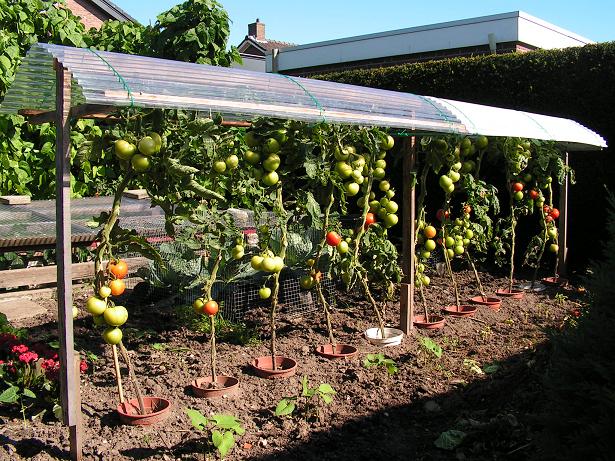Growing Tomatoes
Notes
- Roof over tomatoes. The one I like uses a corrugated panel, curved over posts with crossbars and string to keep the panel curved.
 - Best and Worst Companion Plants for Tomatoes. Some companion plants help improve the health and vigor of the tomato plants, some improve the tomato flavor, and other companion plants are used to repel and deter insect pests and diseases.
- Companion plants for tomatoes: amaranth, asparagus, basil, bean, borage, calendula (pot marigold), carrots, celery, chive, cleome, cosmos, cucumber, garlic, lemon balm, lettuce, marigold, mint, nasturtium, onion, parsley, peas, sage, stinging nettle, sow thistle, and squash.
- Amaranth helps repel insects.
- Basil repels insects and disease, improves growth and flavor. Repels mosquitoes and flies (even fruit flies).
- Borage improves growth and flavor and repels tomato worms.
- Bee balm, chives, dill, mint, and parsley improve health and flavor. Use dill early since mature dill starts to inhibit tomato growth.
- Carrots planted near tomatoes may not get as large as they should, but they will still taste good.
- Garlic repels red spider mites. Garlic sprays help control late blight.
- Stinging nettle nearby improves taste.
- Sow thistle aids growth.
- Do *NOT* grow these plants with tomatoes: cabbage family (including broccoli, brussel sprouts, cabbage, collards, cauliflower, kale, kohlrabi, rutabaga and turnip), corn, dill, fennel, eggplant, peppers, and potatoes.
- Cabbage family will stunt growth of tomatoes.
- Corn pests are the same for tomatoes. One will affect the other.
- Dill will inhibit tomato growth.
- Eggplant, peppers and potatoes are susceptible to early and late blight as are tomatoes. One will affect the other. Keep them separate.
- Fennel secretes a substance from its roots that inhibits tomato plant growth. This secretion affects many other garden plants, too.
|


